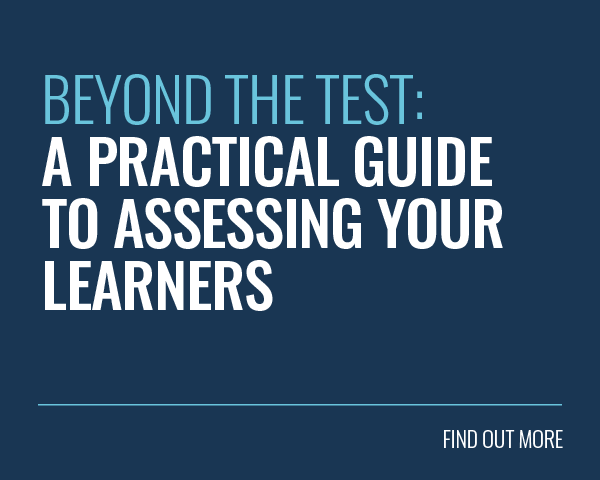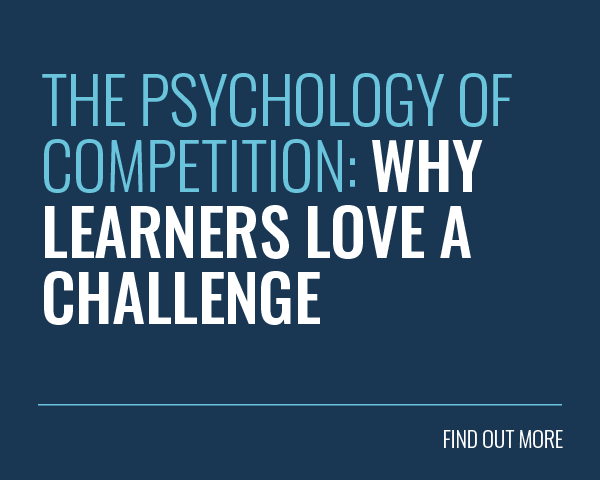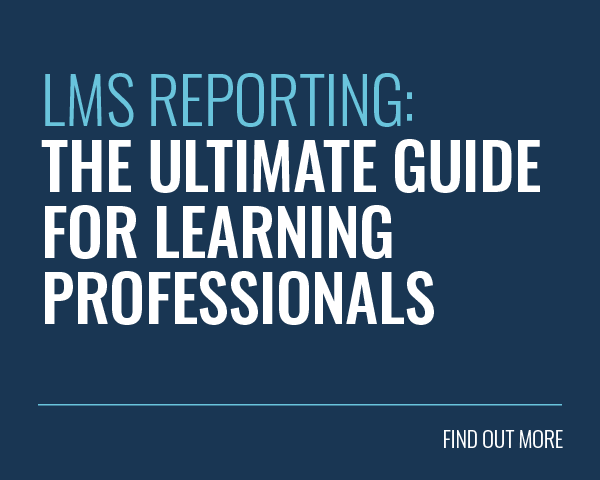Artificial intelligence (AI) is a branch of computer science that seeks to simulate and ultimately replicate human intelligence in a machine. We explored how AI will transform learning and development in a previous article. Now it is time to look at AI based learning platforms.
Technology and innovation provide new ways to meet our constantly evolving social, work, and educational needs. It would be a shame for online learning to not benefit from these technological advances.
Learning platforms help organisations offer learning experiences that produce lasting behaviour change and drive real impact. Artificial intelligence is at the forefront of these technological advances. If its power is wielded effectively, then it can help to significantly boost the impact of your learning platform.
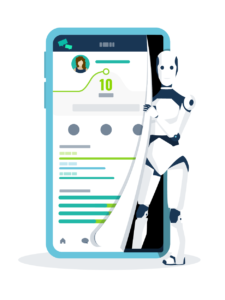 AI brings new capabilities to your learning platform. It can help you satisfy your learners’ needs in new and rewarding ways. AI is capable of recognising patterns that people cannot notice. As a result, an AI algorithm can use these patterns to progressively personalise learning and yield the best result for each individual learner.
AI brings new capabilities to your learning platform. It can help you satisfy your learners’ needs in new and rewarding ways. AI is capable of recognising patterns that people cannot notice. As a result, an AI algorithm can use these patterns to progressively personalise learning and yield the best result for each individual learner.
In addition, AI speeds up the design, development and implementation of eLearning. It can also automate repetitive low-value tasks to reduce their burden and prevent errors.
In fact, according to the European Institute of Innovation & Technology “AI can help remove or minimize time spent on routine, administrative tasks, which can take up to 70% of a healthcare practitioner’s time”. Of course, AI’s influence is not limited to the world of healthcare. AI is revolutionising every industry. Its influence is unparalleled.
But before we explore how AI can be applied to a learning platform, we will take a look at how AI is used in the business world.
Artificial Intelligence in the Business World
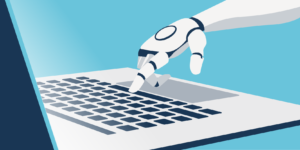
To better understand AI and its utility, it is helpful to look at it through the lens of its business capability. AI can support three important business needs: automating processes, gaining insight through data analysis to make informed decisions, and engaging with customers and employees. Let’s break these down.
1. Process Automation
Robotic process automation (RPA) is the most common type of AI. It is the automation of physical and digital tasks that would otherwise be time-consuming and monotonous for employees to undertake. With businesses under constant pressure to increase efficiencies and reduce labour costs, many are turning to RPA technologies. In fact, Gartner estimates spending on RPA will reach $2.4 billion by 2022!
The financial sector was the first one to use RPA. However, it has now been adopted in a variety of industries ranging from healthcare to manufacturing.
Examples of RPA Applications:
- Processing Orders: RPAs automate the process of taking and fulfilling customer orders. They eliminate manual entry, optimise requirement planning, manufacture scheduling, and more. As a result, there’s a reduction in lead time and customers are able to receive their product as quickly as possible.
- Credit Card Applications: RPA bots process the majority of today’s credit card applications. They quickly gather the required information from a bank’s internal system, check credit scores, and then decide if an applicant is eligible. RPA bots can also carry out the actual issuing process.
- Appointment Scheduling: Particularly in the healthcare industry, RPA technology can help enhance the appointment scheduling process. Using RPA bots helps streamline everything from gathering patient details, location preferences, and patient history.
- Extracting Data: RPA bots can be used to extract key data from lengthy documents or databases. This could include extracting key contact information from a call centre database. It could also “read” legal documents to determine any accounting provisions that need to be made.
In general, RPA is the least expensive and easiest way to implement cognitive (i.e. “thinking”) technologies into your business. It’s relatively quick to implement, with a high success rate and return on investment. For instance, at NASA, an HR automation project was able to complete 86% of transactions without human intervention.
Its major drawback is that it’s the least “smart” type of AI. It relies on human intervention to define the input and output parameters and set algorithmic rules to execute the required tasks. Additionally, any update to the system requires more human intervention, as there’s no built-in learning or improvement capability. However, over time RPAs can get additional modest intelligence and learning capabilities.
Before we move onto the next business application, remember this: If you can outsource a task, you can probably automate it.
2. Cognitive Insight
Cognitive insight (CI) can be thought of as “analytics on steroids”. It is a type of AI which uses self-taught algorithms to detect patterns in large quantities of data and find meaning or outcomes. In these cases, a machine learning (ML) component uses correlation and trial and error to derive and teach itself algorithms which are effective. It is the most common cognitive insight technology.
Cognitive insight differs from traditional analytics as it is much more data-intensive and detailed. It typically trains itself with existing prior data and then makes predictions for the new incoming data to test its algorithms.
However, one major advantage over traditional analytics is that CI models get better over time. Similar to how humans get better with practice, CI bots continuously improve, both in terms of accuracy and efficiency.
Examples of Cognitive Insight Applications:
- Creating customer buying behaviour profiles: CI can build buying profiles for expected customer behaviours and can predict their next likely purchase. Alternatively, such profiles and predictions can highlight unusual purchases and help identify fraud in real time.
- Analysing warranty data: CI supports in the identification of product safety or quality problems, for subsequent corrective action.
- Providing insurers with increased accuracy of actuarial modelling: accidents or illnesses are statistical events. CI can calculate their probability and build this into a model to predict future occurrences. ML can analyse vast amounts of data (relating to previous occurrences) and check in real time for any shifts in the model.
- Image/Speech recognition software: today’s speech recognition software has improved significantly through the use of machine learning AIs which can actually speak the language.
Cognitive insight can also be added to RPA AIs to improve them and make them even smarter. They will then be able to deal with a higher percentage of cases without human intervention. For instance, a large bank used this technology to extract data from supplier contracts and matched it with invoice numbers. From this, they identified tens of millions of dollars in products and services not supplied.
3. Cognitive Engagement
Cognitive engagement (CE) is without a doubt the least used type of AI so far. With this example, language processing chatbots and intelligent agents directly interact with humans, whether they be your employees or outside customers.
This type of AI is still in its infancy. Many remain hesitant to use CE bots. For example, Facebook found that its Messenger chatbots were unable to answer 70% of customer requests without human intervention. As a result, they restricted bot interactions to narrower domains whilst waiting for the technology to progress.
Examples of Cognitive Engagement Applications:
- Product/service recommendations: CI can build profiles and make buying predictions. Following this, CE bots give retailers individualised suggestions to pass on to customers.
- Health treatment recommendations: these can take into account individual health status, previous treatments, and geographical location. They provide us with a glimpse into the future of healthcare.
- 24/7 customer support through chatbots: the ultimate customer service representative: always available, quick to respond and impressively efficient.
AI Based Learning Platforms
In our last article, we explored how AI will help transform learning and development. Now we will explore how learning technology can help facilitate these changes. Let’s dive in!
1. Personalised Learning Experiences
 No two learners are alike. Each of us acquires and processes information differently. This results in the existence of many different learning theories and training approaches. Unfortunately, using human judgement to create personalised learning experiences is highly resource intensive and yields basic results.
No two learners are alike. Each of us acquires and processes information differently. This results in the existence of many different learning theories and training approaches. Unfortunately, using human judgement to create personalised learning experiences is highly resource intensive and yields basic results.
AI and in particular ML are able to recognise individual learning patterns. They make sure each learner receives the appropriate learning object. The ML component teaches itself to recognise learning patterns. It either parses through prior learner information or generates it via A-B testing during the individual’s learning experience.
The individual’s learning profile is refined over time with more and more data. Once enough data has been collected, the AI selects learning objects and delivery mechanics to be incorporated in the personalised learning recommendation.
This is a cognitive insight level AI implementation, typically found within the Recommendations Engine and Invites Engine components of a good learning platform. This AI can also use the output of Robotic Process Automation level AIs to support Content Provisioning or User Provisioning.
2. Workflow Integrated Training
Employees today typically only spend 20 minutes a week focusing on learning. With limited learning time available, your learners would benefit from having bite-size learning interventions automatically integrated into their daily routine.
A Robotic Process Automation (RPA) AI can parse learning objects to tag them and group them into categories. It can also break up training into bite-size chunks. Following this, a cognitive insight AI can find time slots in-between work tasks and intelligently encourage learning breaks throughout the day.
These AIs are normally found within the Content Provisioning (RPA) and Invites Engine (CI) of a good learning platform. The recommendations coming from a Recommendations Engine AI can also help ensure employees consume relevant learning objects.
3. Reinforced Learning and Development
Forgotten or unfinished learning interventions are a drain on employee and organisational resources. Using AIs can help encourage learners to complete their learning tasks and return to topics that need further reinforcement.
Such AIs can apply gamification principles, extract questions from learning objects, generate quizzes, and administer tests. They can schedule learning events, send reminders and use psychological and social incentives to further engage learners.
This AI can also invite groups of learners into a social ‘Club’, where they would be able to display their new knowledge.
Good learning and development platforms offer a Content Creation AI and an Invites Engine AI. These would benefit from the results of Content Provisioning, User Provisioning, and Recommendations Engine AIs.
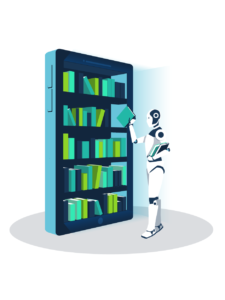
4. Searching and Finding
How often have you searched for something in your garage and been unable to find it? The same problem persists in learning platforms. At times it can be difficult to find the right piece of training content at the point of need. This is where AIs can help.
With a robotic Content Provisioning AI, all your learning content can automatically be parsed, tagged, and categorised. As a result, administrators no longer have to manually tag their content with search terms. Your learners can simply search for relevant keywords to find what they are looking for, every time.
5. AI based Digital Coaches
Imagine if each of your learners had their own personal coach to guide them. Thanks to the power of AI, this is now possible within your learning platform.
This is a cognitive engagement level AI. Several narrow scope AI based digital coaches exist and are very effective. However, many broader scope AI projects have failed and have been abandoned. Remember that Facebook’s chatbots could only answer 30% of user requests without human intervention.
An AI digital coach within learning platforms is an ideal solution for those who already have experience with AI and a specific and crucial need. For others, there are better and less risky ways to spend money on AI implementation within learning platforms. Having said that, the future of AI based digital coaches is still very bright.
6. Improved Completion Rates
 We all have a tendency to put things off until the very last minute. That’s why training completion rates often remain low until deadlines start to creep closer. Unfortunately, this can lead to rushed learning experiences and ‘cramming’, which is known to be an ineffective learning approach.
We all have a tendency to put things off until the very last minute. That’s why training completion rates often remain low until deadlines start to creep closer. Unfortunately, this can lead to rushed learning experiences and ‘cramming’, which is known to be an ineffective learning approach.
With an ML based Recommendations Engine, you can ensure that your employees never waste time on irrelevant learning.
At the same time, an ML based Invites Engine will find the best way to prompt, encourage, pressure (a little bit of stress is healthy), and engage users. The AI can also reward them virtually with points, badges, awards, and status. This raises their interest and creates a virtuous circle.
As a result, your employees will happily be up-to-date, and complete learning steadily and early throughout the year.
7. Learning and Training Effectiveness Measurement
So far, evaluating the performance of learning initiatives has been very difficult. It usually takes place once the learning initiative is complete, rather than during (when it would be most effective).
Keeping track of your training’s effectiveness helps you to make better informed decisions. So why not deploy an ML component to continuously monitor the performance of your learning initiatives?
You can even manually link specific learning objects or interventions to sales and business results. This will help the AI focus on the learning interventions which produce the best outcomes.
A learning platform’s Recommendations Engine is ML based and uses performance metrics to select which learning objects to recommend. An Invites Engine is also ML based and utilises performance metrics to pick how and when to best deliver content for maximum results.
Content Provisioning and Content Creation are robotic process automation AIs. These help cognitive insight AIs to do their job even better.
8. Universality
ML components can deal with very large amounts of information and derive meaningful insights. This is true even for diverse employee backgrounds, levels of education, and types of personalities.
A learning platform’s ML based Recommendations Engine increases inclusiveness and universality as it tailors learning for everybody. At the same time, a learning platform’s Content Creation AI ensures content is available for diverse groups, including those who speak a different language or those with disabilities. It is capable of duplicating content, translating it, reformatting it, republishing it, and more.
The prior processing of user information and available content via User Provisioning and Content Provisioning AIs provides inputs useful to the above AIs.
Debunking The Myths That Prevent AI Adoption

A 2020 survey by McKinsey showed that 58% of all organisations have already incorporated AI into at least one business function.
While most business leaders understand the benefits of AI, many cite a lack of knowledge and guidance as a challenge to further adoption. This hesitation is perpetuated by common myths surrounding its use within small businesses.
Let’s explore further and debunk some of the AI myths that persist in the business world!
Myth #1: AI Is Just For the Big Guys
AI solutions can offer improvements to any business, regardless of size. Smaller organisations fear the costs associated with AI, but there are entry level solutions that are capable of generating significant ROI.
In small businesses, AI can:
- Automate laborious and time-consuming tasks.
- Increase team efficiency.
- And reduce the need for highly paid labour.
Myth #2: AI Is Complex And Requires Vast Technical Knowledge
The reality is that most AI tools require little to no interaction to perform their tasks. Once the process is programmed, an RPA bot will carry out its specified tasks unsupervised, without the risk of human error. Likewise, once an ML component has self-taught itself with data, it will perform categorisations and recommendations with little human supervision.
The right AI solutions are intuitive and can be seamlessly built into a company’s service channels and CRM data.
Myth #3: AI Implementation Is Too Expensive
The key here lies in identifying the most viable and effective AI for your business. Sure, advanced machine learning (ML) software can be costly, but this sort of AI has limited business applications. You may find that a simpler form of AI is more than able to meet your needs.
In fact, process automation bots are generally inexpensive, with a great ROI and fast results. Remember that AI is an investment, not an expenditure. According to Accenture, the impact of AI technologies on businesses will increase labour productivity by up to 40%.
Final Words
After exploring how AI can transform learning and development, we have now looked at how AI can be applied to learning platforms.
We have reviewed how different types of AI can serve the business world. This includes robotic process automation, cognitive insight, and cognitive engagement.
And then we looked at how AI can work to transform learning platforms through personalising the learning experience, recommending training interventions, providing a digital coach, measuring effectiveness, and more. The AIs that drive these improvements typically focus on user and content provisioning, content creation, and fuelling a Recommendations Engine.
There’s a lot to explore here. And you can’t achieve everything at once. But there’s no reason why you can’t start exploring the power of AI today. Start with a goal in mind and go from there. With enough dedication, you’ll be amazed at what you can accomplish!
AI based learning platforms have the capability to boost the effectiveness and efficiency of online training! They also help automate repetitive low-value tasks to reduce their burden and prevent errors! If you want your training initiatives to benefit from this, contact us today to find how the Growth Engineering Impact Suite can help you!
Unlimited Learner Engagement on
The Impact Suite



